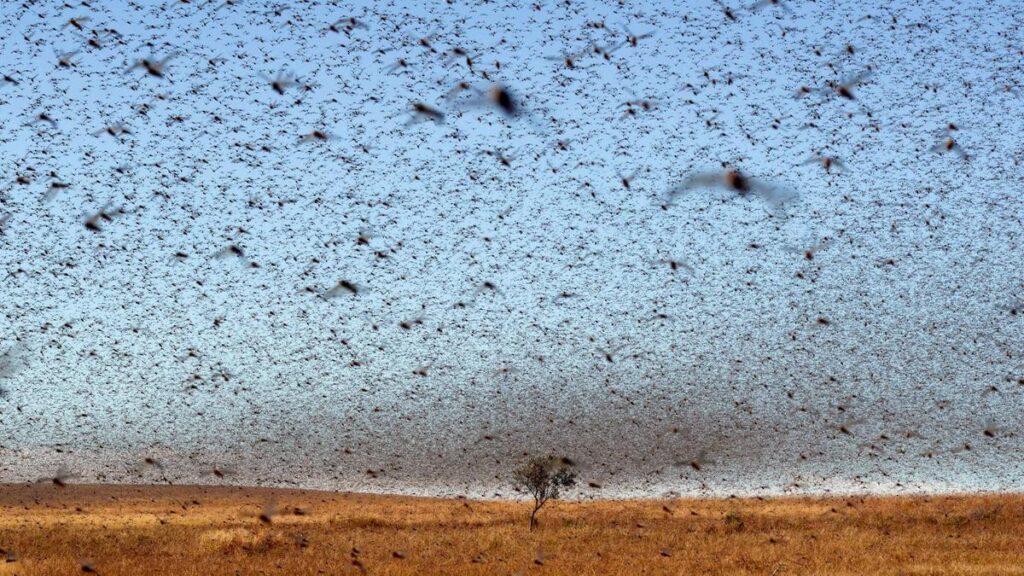Climate change and increasing pollution directly harm not just humans, but also affects agricultural and fruit crops – exacerbated due to the intensity of pest attacks. As global temperatures rise, insects are proliferating across the planet, which scientists say will threaten food production, particularly in bio-diverse countries like India.
Threat to food security
The Ministry of Agriculture has mentioned to a parliamentary committee that crops such as paddy, wheat, maize, sorghum, mustard, potato, cotton and coconut are likely to be adversely affected by climate change. The committee headed by veteran BJP leader Murli Manohar Joshi states that wheat production will decrease by 6-23% by 2050 if effective steps are not taken in a timely manner. Wheat production could decrease by 6,000 kilos for every 1°C increase in temperature.
According to India’s National Action Plan on Climate Change, maize production could fall by 18%; paddy may witness a fall by 4-6% by 2020, and potatoes would show a decline by 2.5% by 2020, 6% by 2050 and 11% by 2080. Soybean is, however, predicted to fare better in the future, with its production likely to increase by 8-13% from 2030 to 2080.
India as a whole will experience 1-1.5 degrees Celsius increase in mean annual air temperature from 2016 to 2045, which could have profound implications for agriculture, according to a study by IIM Ahmedabad, IIT Gandhinagar and Council on Energy, Environment and Water. These effects could be further pronounced given the estimated increase in heavy rainfall and snowfall, resulting in flooding and damage to infrastructure.
Climate change will affect agriculture, but its exact impact is difficult to predict. However, it can be said without any ambiguity that increasing pest population are a threat to food security—for the pests love a warmer world.
Insects are vital to our ecosystem as they pollinate crops and flowers, provide food for higher-level organisms, break down the detritus, maintain a balance in ecosystems by eating the leaves of plants and help recycle nutrients in the soil. However, they also consume somewhere between 18% and 26% of crops produced around the world, a loss valued at USD 470 billion.
Insects burn calories at a faster rate when their surroundings heat up, forcing them to consume more. Elevated levels of carbon dioxide can increase levels of simple sugars in leaves and lower their nitrogen content. This can increase the damage caused by many insects, which will wolf on more leaves to meet their metabolic requirements of nitrogen.
Explaining the phenomenon V.V. Ramamurthy, Division of Entomology, Indian Agriculture Research Institute (IARI), New Delhi, says, “As insects are cold-blooded organisms, the temperature of their bodies is approximately the same as that of the environment. Due to global warming, when the temperature rises, and also the relative humidity with more rainless humid days, the sucking pests, in particular, are likely to multiply. Also, due to climate change in hilly terrains, there will be an upward movement of insect population. In this process, at least temporarily there will be extensions in range.”
The pest menace
Several minor pests have become major due to change in agricultural practices and climatic variability. Take, for instance, the brown planthopper. It was a minor pest in rice of no economic significance till its outbreak in Kerala in 1973-74. An infestation of brown planthopper in Basmati (aromatic) and non-Basmati rice in western Uttar Pradesh, Haryana and Delhi are recent examples. Another example is of the spotted bollworm which completes its life cycle in 88 days when the temperature is 16 degrees Celsius, but at 25 degrees, the lifecycle reduces to 31 days, which means more pests.
Incidents of thrips (a sucking pest) attack on crops like groundnut, cotton, chilli, roses, grapes, citrus and pomegranates are being reported. There are also more frequent attacks of diamondback moth in cabbage, and hoppers on mango. In layman’s terms, the appetite of the caterpillar is likely to rise as the earth gets warmer.
Increased temperature results in the extension of the geographical range of pests and pathogens and sudden outbreak of some notorious pests, according to R.R. Patil, Professor of Entomology at the Department of Agriculture and Entomology of Dharwad-based University of Agriculture Sciences.
Researchers at the Coimbatore-based Tamil Nadu Agricultural University having studied the effect of elevated temperature on the development time of rice Yellow Stem Borer (YSB), revealed that the number of eggs laid increased at higher temperatures, while egg hatching was reduced. Insects develop faster, which may be why they lay eggs early, and hence, the population is likely to grow earlier than expected.
Studies undertaken by Indian scientists on the trends of temperature rise, heatwaves, droughts and floods, and sea-level rise are in consonance with the findings of the Intergovernmental Panel on Climate Change (IPCC), though the magnitude of changes could differ.
The mean temperature in India is projected to increase up to 1.7 degrees Celsius in the Kharif season (July to October) and up to 3.2 degrees during the Rabi season (November to March). Mean rainfall is expected to increase by 10% by 2070, a scenario leading to a situation affecting many familiar insects restricted to smaller habitats while new pests spread over wider areas.
Invasion by migrant pests due to global warming has become a fact which farmers in India have to deal on a regular basis. Also as quarantine regulations are diluted due to free-trade agreements, more pests are likely to get into areas previously free of them. The most recent case is that of the dreaded Fall Army Worm (FAW) pest (Spodoptera frugiperda), which mainly devours maize in its caterpillar phase, but can feed on more than 80 plant species, including other key crops like rice, sorghum, cotton and vegetables.
First spotted in Africa in 2016, it has spread rapidly through the sub-Saharan belt and has created havoc in some 10 states in India, first spotted in Karnataka. According to Down To Earth magazine, the worm though detected mostly in maize crops—a preliminary calculation estimates it has affected nearly 170,000 hectares (ha) of maize crops—there have been reports from states where it has infested paddy, sugarcane and sweet corn.
Protecting the crop
As pests are part of natural ecosystems and compete with humans for their existence, crop protection technologies are likely to be less effective and need to be customised to suit the climate changes. We are looking at a future when the effectiveness of traditional crop protection technologies will be put to test. In such a situation, pest forewarnings are likely to provide a lead time for impending attacks and thus minimise crop loss and optimise pest control leading to reduced cost of cultivation.
How do we deal with the situation? Make integrated pest management methods the norm, says Nigel Andrew, Professor of Entomology at the University of New England and Fellow of the Royal Entomological Society. He adds: “Cultural methods of insect control will need to be re-introduced and used more extensively. Areas of alternative habitat will need to be replanted on to farms to enable predators and parasitoids to be active. Methods such as sterile insect techniques will also need to be used as alternatives to chemical controls.”


 [/column]
[/column]